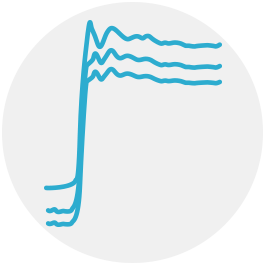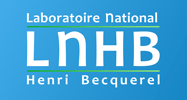Techniques d’analyse par fluorescence X

L’analyse X par incidence rasante (XRR ou GIXRF) permet de caractériser en profondeur et aux interfaces des matériaux déposés en couches minces, utilisés dans différents domaines d’applications : électronique de puissance, énergie solaire photovoltaïque, fenêtres éco-énergétiques. Cette caractérisation est effectuée en faisant varier l’angle d’incidence du rayonnement sur l’échantillon.
La spécificité des matériaux étudiés, en termes de dimensions et de composition chimique, constitue un défi pour les méthodes analytiques. Pour y répondre, les méthodes d’analyse X (XRR, GIXRF, etc.) sont utilisées en complément afin de recueillir un maximum d’informations (dimensionnelles et structurelles) sur les paramètres des échantillons.
Le LNHB développe ces techniques sur la ligne de Métrologie du synchrotron SOLEIL, en utilisant un goniomètre dédié. L’analyse des données expérimentales inclut le traitement détaillé des spectres de fluorescence qui présentent une structure complexe grâce à un logiciel dédié (Colegram). L’ensemble des résultats doit être traité à l’aide de codes de simulation afin de déterminer les paramètres étudiés (profil de distributions des éléments, quantité déposée, densité, état chimique, etc.).
RÉFÉRENCES BIBLIOGRAPHIQUES :
– Y. Ménesguen and M.-C. Lépy, « Metrology of thin layer deposition with combined XRR-GIXRF analysis at SOLEIL », Proc. SPIE 11611, Metrology, Inspection, and Process Control for Semiconductor Manufacturing XXXV, 116110I (22 February 2021)
DOI : 10.1117/12.2583702
– Y. Ménesguen and M.-C. Lépy, « Reference-Free Combined X-Ray Reflectometry – Grazing Incidence X-ray Fluorescence at the French Synchrotron SOLEIL » (2021) Physica Status Solidi A 2100423.
DOI : 10.1002/pssa.202100423
– S. Torrengo, D. Eichert, Y. Mazel, M. Bernard, Y. Ménesguen, M.-C. Lépy and E. Nolot, « Quantitative depth-profile analysis of transition metal nitride materials with combined grazing-incidence X-ray fluorescence and X-ray reflectometry analysis » (2020) Spectrochimica Acta Part B 171, 105926 E.
DOI : 10.1016/j.sab.2020.105926
– Nolot, W. Pessoa, S. Torrengo, Y. Mazel, M. Bernard, P. Gergaud, Y. Ménesguen, M.-C. Lépy and D. Eichert, « Grazing-incidence X-ray fluorescence analysis of thin chalcogenide materials deposited on Bragg mirrors » (2020) Spectrochimica Acta Part B 168, 105864.
DOI : 10.1016/j.sab.2020.105864
– W. Pessoa, A. Roule, E. Nolot, Y. Mazel, M. Bernard, M.-C. Lépy, Y. Ménesguen, A. Novikova, P. Gergaud, F. Brigidi, D. Eichert « Grazing incident X-ray fluorescence combined with X-ray reflectometry metrology protocol of telluride-based films using in-lab and synchrotron instruments » (2018) Spectrochimica Acta Part B, 149, 143-149
DOI : 10.1016/j.sab.2018.07.003
– H. Rotella, B. Caby, Y. Ménesguen, Y. Mazel, A. Valla, D. Ingerle, B. Detlefs, M.-C. Lépy, A. Novikova, G. Rodriguez, C. Streli, E. Nolot « Elemental depth profiling in transparent conducting oxide thin film by X-ray reflectivity and grazing incidence X-ray fluorescence combined analysis » (2017) Spectrochimica Acta Part B, 135, 22-28
DOI : 10.1016/j.sab.2017.06.011
– Y. Ménesguen, B. Boyer, H. Rotella, J. Lubeck, J. Weser, B. Beckhoff, D. Grötzsch, B. Kanngießer, A. Novikova, E. Nolot and M.-C. Lépy « CASTOR, a new instrument for combined XRR-GIXRF analysis at SOLEIL » (2016)
DOI : 10.1002/xrs.2742
Métrologie des paramètres fondamentaux X
En parallèle, les aspects métrologiques des données X sont étudiés afin d’assurer la qualité des résultats quantitatifs. En particulier, des mesures de paramètres atomiques (coefficients d’atténuation, rendements de fluorescence) sont effectuées pour les éléments d’intérêt et les valeurs obtenues comparées aux valeurs utilisées dans les codes de calcul, pour être éventuellement intégrées dans ceux-ci. Les résultats expérimentaux des coefficients d’atténuation sont disponibles sur le site suivant : http://www.lnhb.fr/Laraweb/Mu
